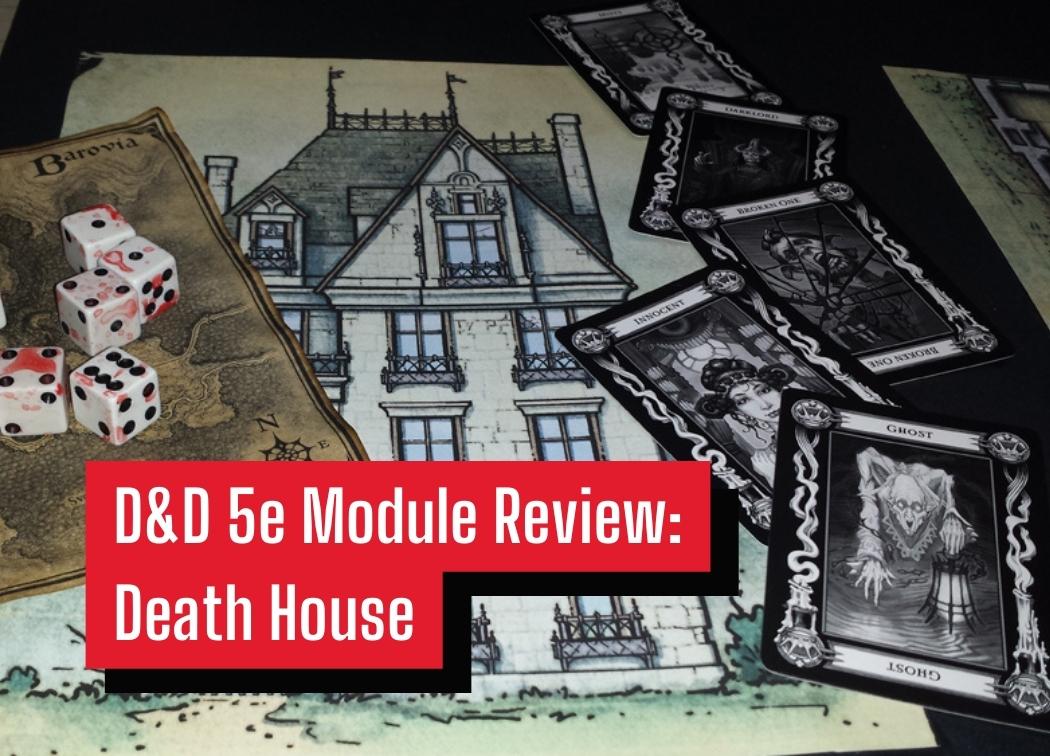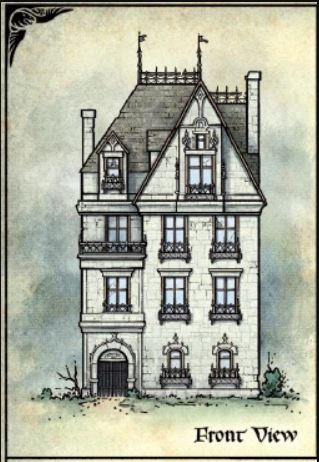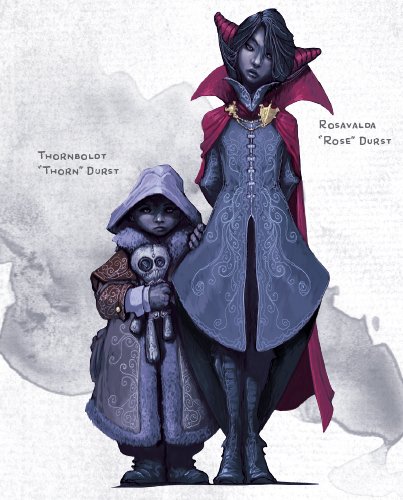D&D 5e Module Review: Death House

My Curse of Strahd campaign is chugging along. The party has just finished Death House. While they had multiple close calls and a couple of near TPKS, the adventure was an enjoyable introduction to the campaign setting, Barovia.
I initially gave the group the option of either starting at level 3 or running Death House at level 1. In hindsight, they’d probably choose the level 3 start. Those poor lads’ heart rates have been sky-high ever since they squared-off against the animated armor.
It’s also offered by WotC for free as either a sampling of CoS or as a standalone haunted house adventure that’s perfect for a Halloween one-shot!
It’s tough, it’s scary, it’s… the Death House!
Beware: turn back now if you don’t wish to see a ton of spoilers!

Formatting
I don’t want to be too critical because it is an older adventure, but it’s, frankly speaking, a bit of a mess. There’s text everywhere making it a dense read. It’s 12 pages, but it feels like more. It’s so wordy!
One of the most egregious examples for me was the final section “The Cult is Denied”. The formatting separates different aspects of the house’s dangerous transformation into bullet points. However the bullet points aren’t condensed bits of information, they’re whole paragraphs of text.
Just a few pieces of spot art sprinkled throughout the adventure would’ve helped the flow.
While I did my original read-through in the book, I used the handouts provided in the Roll 20 version (thanks again!) while we played. It felt much more accessible during game-time. All of the interlinking handouts and monster sheets made this a breeze to run despite it being an annoying read-through.
Background Info
Despite being a stepping-stone for a campaign, there’s not much background information that the DM needs outside of the adventure. The Durst family’s and the house’s history is condensed into about one and a half pages. This also includes the initial plot hook information.
Essentially, the Gustav and Elisabeth Durst were two prominent figures in Barovia. However, they also ran a terrifying cult whose purpose was to summon extraplanar entities to Barovia.
Their rituals failed, but that only made the cultists more desperate. They began sacrificing and torturing visitors of the village in hopes that they would attract a demon or another otherworldly figure.
Eventually, Strahd von Zarovich arrived in Barovia. The cult was ecstatic thinking that their rituals worked. Yet it was a coincidence.
In fact, Strahd hated this obsessive cult. He left them alone until they accidentally tortured and killed adventurers he brought into his domain as guests playthings. Strahd slaughtered the cultists and left their spirits to haunt what is now the Death House.
There’s more to it than that, but that’s a decent summary of the background info. I think it’s a great backstory, and the story is told in bits and pieces to the party as they explore the house.
Plus, It introduces a lot of themes showcased throughout CoS and gives the DM more info on Strahd. All of this is valuable info for those of us running CoS, but the general theme of “cultists being killed by a greater entity” is easily modified for those running this as a standalone adventure.
The Hook
I combined the campaign introduction my party decided on and weaved it into “The Creeping Fog” plot hook from the first chapter. Essentially, the party appears on a road surrounded by a strange fog/mist. Their options are to travel toward Barovia or travel in the other direction and wind-up where they appeared.
This worked really well, but it is railroady. That’s not a bad thing, mind you. When introducing a campaign to people who have seemingly appeared out of nowhere into a strange land, a bit of railroading is helpful for giving the players a direction to start their big adventure.
Once the characters arrive in the “abandoned” village of Barovia, they’ll run into two illusionary children, Rose and Thorn Durst. They claim that there’s a monster in their house and they’re worried about their baby brother that’s inside.
They worked as a fantastic way to get the party to check out the house which is all that is required. Once the party approaches the house, the mist quickly surrounds them, trapping them inside the Death House until they confront the “monster” in the basement.

Maps
Thanks to Roll 20’s map pack I circumvented the need to prep the maps and creatures for this adventure (and the rest of the campaign). While I did get a free review copy of CoS from them, I will say that even if I didn’t I’d purchase this going forward if we were to do another hardback campaign.
My group has played on VTTs for about 6 years now. The majority of my prep is spent filling in sheets for monsters, doing the dynamic lighting, and creating maps. This is hours of work. $25 to avoid a year’s worth of this work is well worth the price.
My only critique is that I wish there were some lamp tokens in the GM Layer that could be brought into the token/map layer when they’re lit by the players. Not a big deal, but it would’ve been a nice addition.
Enough about Roll20 though.
The maps are beautiful. They’re colorful, but use a pallet that emphasizes the dreary, abandoned building that was once the Durst family’s home. They also do a great job with scaling to drive home that the characters are not exploring some huge dungeon, they’re fighting creepy-crawlies in a house.
Running the Module
Death House wasn’t difficult to run despite the rough formatting. I read the adventure once, skimmed through it before playing, and was good to go.
I also intentionally left it as-is to help gauge the difficulty of the campaign for my party as it includes two extra characters than the intended party size of four.
Encounter Balance
The fights were cool, flavorful, and dangerous. All of which is great for a romp in a haunted house.
However, things were a bit… too dangerous. Even with two extra party members, there were fights that were unnecessarily deadly for a level 1 or 2 party.
As a one-shot, I think this is fine. Especially for a scary Halloween one-shot! Yet, as an introduction to a long-term campaign, I think it was too heavy-handed.
Look, I believe character death is a necessary part of my D&D games, but during the first or second session of a year-long campaign? It’s a bit much. Not to mention the fact that we had multiple near-TPKs during these first 2 sessions.
This is with experienced players mind you. In fact, it was with two additional experienced players! I can’t imagine throwing a group of new players into this as a campaign intro without seriously nerfing some fights.
All in all, I think this was a huge weak-spot in what is a flavorful and cool adventure, but let’s get into some of the specific fights.
The House
Exploration of the house was well-done. There aren’t many fights in this portion and everything is well-balanced.
The fights were dangerous for a party of level 1 characters, but nothing was unfair or unbalanced. I even did some Kobold Fight Club calculations to double-check it and everything came up good mathematically.
The only issue the group had was with the specter. The creature put up a fair fight, but her Life Drain almost straight-up murdered the party’s fighter if he didn’t make the DC 10 Constitution save.
Thankfully he did, but it was a close call.
The Basement
All in all, most of these fights were solid. The shadows kicked the party’s ass, but it felt good throwing those back on the party after they used one against me for the majority of their last campaign. Still, it was a tough, but fair fight.
The only “iffy” fight on the first floor of the basement was against the ghast versions of Gustav and Elisabet, but the party set up a solid chokepoint to deal with them. It was a tough fight, but tactical combat made the “on paper” fight scarier than the real thing.
Lorghoth the Decayer, a shambling mound, was both the final boss of the adventure (depending on the ending the party chose) and the most ridiculous fight in the adventure. Sure it’s a slow creature, but just one of their attacks is enough to demolish a 2nd-level character.
The party was stacked with healing so they were thankfully able to keep reviving their downed comrades, but the fight was still a very close call.
So close, that when we went over it after that session a few players questioned if a party of four would’ve been successful if I didn’t pull (theoretical) punches against them.
The Escape!
If the party fights Lorghoth, aka decides not to sacrifice a living creature on the altar in the basement, they’ll also need to escape from a transformed version of the Death House. Upon leaving the basement they’ll find that the house has the following changes:
- Deadly scythes swing across the doorways
- Billowing smoke obscures vision and can cause poison damage in rooms with ovens/fireplaces
- The interior walls are destructable and have swarms of rats in them
- The windows are bricked up, preventing escape
The party found the secret ladder that leads up to the living room on the first floor. It made this whole part much easier, but it was still a unique challenge.
There’s an opportunity for a long rest in the basement if the party decides to take their time. Ergo, this section isn’t all that bad if the party is smart about their escape and has some healing.
It’s dangerous, but it does reward the party for exploring the mansion since finding secret entrances and having a full understanding of the blueprint of the house leads to a quicker and more efficient escape.
Storytelling
The storytelling carries this adventure so hard. I cannot stress enough how awesome and thematic this story is as CoS. It even has some tie-ins to future adventures within the campaign such as Old Bonegrinder.
Yet, it’s not the story itself that’s the ingenious part. The way the story is told is so awesome.
Much of the story is pieced together through exploration. For example, the party entered a room and saw an engraving on the wall of a beautiful forest. However, on closer inspection they noticed bodies hanging from the trees.
Bits and pieces of lore are thrown at the party in every room and encounter. Eventually, they’re able to piece everything together and make their own assumptions as to what the Drust family’s secret is, what happened to the cult, and what happened to the poor Rose and Thorn.
The only downside to this method of storytelling was the encounter balance. Sure, they killed everything prior to exploring the basement, but they had no intention of backtracking through the upper-levels of the house to confirm that.
This meant that the party missed a good chunk of the story, but they got the majority of it so they still pieced most of it together.
Secrets Everywhere!
The Death House is full of secrets. Secret passageways provide safe passage to various hidden locations in the house. Secret rooms may house treasure or tidbits of information about the Durst family.
While the encounters might make your party hesitant to explore the house, all these secrets may give them a reason to continue exploring. Plus, the fact that the attic can’t be accessed otherwise. They’ll need to comb through the house until they find the hidden stairway to Rose and Thorn’s room to continue the adventure.
Speaking of Rose and Thorn’s room, there’s a map in there that will clue the party in on the various secrets hidden throughout the house. The children’s room contains a dollhouse that is a to-scale version of the house. Upon studying it, PCs gain advantage for finding the secrets in the house.
The dollhouse was a unique and flavorful addition of a map. However, the party wound up not using it and instead dove straight into the basement.
Final Thoughts on Death House
All in all, we had a fun time with Death House. I cannot stress enough how great of an introduction it is to Curse of Strahd’s story, locations, and themes.
Hell, Death House’s story and exploration are both top-notch even as a standalone adventure. You could practically run it as-is just by changing the references to Barovian names and locations to ones that match your setting.
Of course, it’s not without flaws. The formatting is quite rough, but the largest flaw is by far the encounter balance. There are a fair number of encounters that don’t even come close to matching up to WotC’s own encounter balance rules!
Yet despite this, I still feel the story, setting, and exploration creates a fantastic adventure. D&D is a combat game first and foremost. The fact that the combat is carried by the story is a testament to how great it is.
